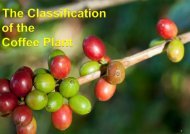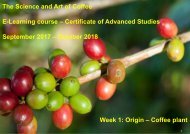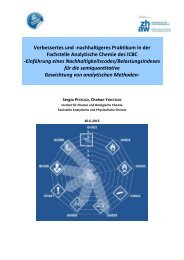Create successful ePaper yourself
Turn your PDF publications into a flip-book with our unique Google optimized e-Paper software.
Next to Arabica and Robusta, few o<strong>the</strong>r species can are commercially available, e.g. as roasted c<strong>of</strong>fee.<br />
One such species is C<strong>of</strong>fea liberica that has a trading volume <strong>of</strong> under 1 % <strong>of</strong> all c<strong>of</strong>fee. Next to Liberica<br />
also Excelsa is listed as a trade species. But recent publications from A.P. Davis suggest to group based<br />
on genetic analyses a couple <strong>of</strong> species in <strong>the</strong> “liberica alliance”, which consists <strong>of</strong> C. liberica var. liberica<br />
(actual Liberica c<strong>of</strong>fee), C. liberica var. dewevrei (formerly known as Excelsa c<strong>of</strong>fee), as well as C.<br />
montekupensis, C. bakossi and C. mapiana.<br />
Liberica c<strong>of</strong>fee originated from <strong>the</strong> coast <strong>of</strong> West Africa, but being a beverage species it is now found in<br />
most <strong>of</strong> tropical Africa and also cultivated on <strong>the</strong> Philippines, Indonesia and Vietnam. This is likely due to<br />
<strong>the</strong> large beans that this c<strong>of</strong>fee species produces, which is somehow correlated with high quality, even<br />
though <strong>the</strong> c<strong>of</strong>fee produced from Liberica is far from <strong>the</strong> high quality that can be produced from Arabica<br />
c<strong>of</strong>fee. Liberica grows as a very large tree that can grow up to 25 m. Consitently, Liberica has also very<br />
large leaves (up to 50 cm in length), which is a good identifying characteristic in <strong>the</strong> field. Being a large<br />
<strong>plant</strong>, also <strong>the</strong> cherries are a lot larger and harder compared to Robusta and Arabica. With 12 to 14 months<br />
<strong>the</strong> cherries also need a longer time for maturation.<br />
There are also some advantages in growing this species. It is rust resistant and it has a high drought<br />
tolerance, which means it can grow in most <strong>of</strong> <strong>the</strong> drier regions on <strong>the</strong> African continent.<br />
29








